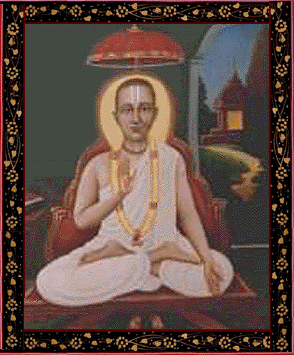

"Both Jiva Goswami in his Bhagavata Sandarbha and Krsnadasa Kaviraja in his Caitanya-caritamrta look to Sripad Visnuswami for inspiration to establish the essential difference between God and the individual souls and quote from his Sarvajnasukta, his commentary on Vedanta.
Visnuswami is the founder-acarya of the Rudra sampradaya, which is the oldest of the four recognized sampradayas. It is even said that Visnuswami was born in the Dravida country after the completion of the sacrifice of Janamejaya, around the beginnining of Kali-yuga.
Although most scholars are only able to find scanty and conflicting information on Sripada Visnuswami, Srila Bhaktisiddhanta Sarasvati Thakura gives us a authoritive biographical account of Visnuswami which we accept to be authoritive.
There were three Acaryas bearing the name of Visnuswami in the Rudra sampradaya. The first is called Adi Visnuswami, who is said to have been born about the third century B.C. in the Pandyan country. Visnuswami's father Devesvara was the royal priest and minister. Devatanu, as he was known before he took the sannyasa name of Visnuswami, was trained by his father in a vigorous theistic eduacation, to fight Buddhism. The Pandyan king exerted all his influence to crush Buddhism in particular and other non-vaisnava sects in general. King Pandyovijaya and his minister, Devesvara, went to Puri and recovered the Deities of Jagannatha, Balarama and Subhadra, which had been turned into the Buddhist Dharma by Buddha and Samgha by the Buddhists. King Padyovijaya and Devesvara removed the deities from the main temple to sundaracala about two miles away by cart. This is said to be the origin of the Rathayatra of Jagannatha. Now the ceremony of conveying the Deities from the temple to the car is named Pahandi or Panduvijaya. The word Panda is applied to the priests of Jagannatha and is said to be derived from the "Pandya". The Deities were again brought back to the temple after Buddhism had been supressed to some extent.
Visnuswami was the first to adopt tridandi sannyasa which he brought into practice among his seven hundred sannyasa disciples. It was he who introduce the Astottara satanami sannyasa (108 designations of sannyasis) including the dasanami which was adopted by Sankara in his sect. It was not Sankara who originated it, as some scholars think. Vyasesvara was the last in the line of Sannyasis, after whom the line became almost extinct, until it was revived by Raja Gopal who also assumed the name of Visnuswami in the beginning of the 9th century. His main follower was Bilvamangala.
Raja Gopala Visnuswami revived the old Visnuswami line and began the active propaganda with renewed vigour and enthusiasm. He installed the Varadaraja temple in Kanci, Ranchorlal in Dwaraka, and many other Deities in different places of pilgrimage. He converted many of Sankara's prominant disciples after Sankara's death.
After the disappearance of the second Visnuswami a great feud took place between his community and that of Saivasivaswami, who regards Rudra as an independant God while the former holds Rudra as Guru and the intimate associate of Visnu. The Saiva opposed it vigorously and peoplefailing to appreciate the subtle point of theism in the Suddhadvaita system of Visnuswami became inclined to Saivite monism, which soon became embraced by the population in general. The Saivaite community, taking advantage of the situation, tried to misappropriate Visnuswami's Sarvajnasukta and modified it to a great extent to suit their system.
The third revival came under Andhra Visnuswami in the 13th century, whose successors included Laksmana Bhatta, the father of Vallabhacarya. This Visnuswami is said to have been the son of a minister of a Dravidian prince under the Emperor of Delhi.
Visnuswami's philosophy is visuddhadvaita. Brahman as Visnu, Narasimha, non-dual and having no second. Brahman has all contradictory qualities. The soul is part of Brahman like spiritual sparks, real, eternal, atomic and dependent. Creation has no motive , it is like a cosmic game and it directly emanates from Brahman. The cause of bondage is one's attachement to karma. The process of release is devotion based on Bhagavata. The goal of life is to attain uninterupted contact with Krsna, Vaikuntha salokya where there is no return."
Modified version of a posting to soc.religion.vaisnava by Nathan Parker, 1995
![[BVML Home Page]](../../grfx/bml_logo.gif)
